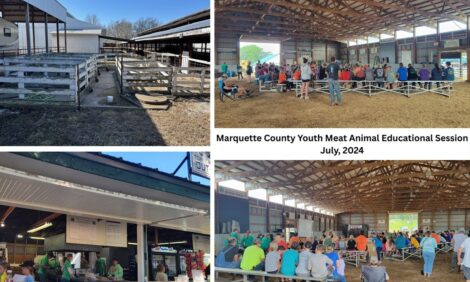



How Do US Agencies Prevent Animal Disease Importation?
US - To keep livestock healthy in all parts of the world, APHIS monitors outbreaks of disease in the United States and abroad.APHIS - the Animal and Plant Health Inspection Service of the United States Department of Agriculture (USDA) - monitors international and national outbreaks of disease in animals.
At every major border, international airport and sea port, APHIS has trained agents to inspect cargo. Agriculture security was discussed before the United States House of Representatives Agriculture subcommittees in March.
“We only allow imports when we believe it’s safe,” said Kevin Shea, administrator of APHIS.
Live cattle and the beef products from different countries are tested at the borders before being allowed to enter the country, said Jack Shere, acting deputy administrator of APHIS Veterinary Services.
“Early detection is the key to prevent a major outbreak,” he said.
With cattle, the primary diseases APHIS is concerned with are Brucellosis (also called contagious abortion or CA), Tuberculosis (TB) and Foot-and-Mouth disease.
The last major outbreak of Foot-and-Mouth disease in US cattle was in the 1920s, Mr Shere said.
When crossing the border into the US, any animal that has the liaisons typical of Foot-and-Mouth disease will be quarantined and tested.
TB and CA can transfer from cattle to humans, Mr Shere said. Both diseases are statistically eradicated from the US cattle market, but some isolated incidences still appear occasionally. The diseased cattle usually contract the bacteria of TB or CA from bison or wildlife that may mingle with the herd.
Cattle fever ticks can spread disease across the borders. As a result, animals entering the US are dipped to kill the ticks and the ticks’ eggs, he said.
“We can then bring (the livestock) into the United States with confidence that we aren’t bringing a problem,” Mr Shere said. “All these existing programs and mitigations are in place to protect the US border.”
Canadian cattle are tested before they cross the boarder for slaughter in US processing plants. The meat is then return to Canada because they do not have the plants needed for the processing.
The agreement with Canada, and APHIS officials understanding of the existing veterinarian structure in Canada, allows the US and Canada to have a reciprocal agreement. Officials from the two countries audit the other country occasionally, but the officials generally trust that diseased animals or contaminated meat will not be allowed to cross the border, Mr Shere said.
There are three quarantine centres in the US to hold animals while tests are run. The centres are located in California, New York and Florida. Everything from cattle to zoo animals may be quarantined at the centres, Mr Shere said.
With all the protections and testing in place, APHIS agents still have to work closely with state officials and producers.
“The best thing to do is work with commercial producers so they know where the threats are coming from and how to mitigate them,” Mr Shere said. “It’s an educational process.”
APHIS is always monitoring for disease outbreaks in other countries.
“We do risk assessments on countries. We look at their veterinary infrastructure, look at what disease they have present and then we decide how risky it is to bring certain things from those countries and we write policies and regulations based on those risk assessments,” Mr Shere said. “Each country is going to be a little bit different.”
If a country has a known outbreak of a disease, then restrictions would be put in place for that country, he said.
If an outbreak of disease occurs within the US, other countries will place restrictions on what imports they will accept from the United Sates. Last year’s outbreak of avian influenza in the midwest region of the US is the most recent example of wide-spread restrictions on US agriculture exports.
Mr Shere said different countries placed different restrictions. Some countries did not want poultry from the effected counties and sometimes effected states. In extreme cases, some countries would not accept poultry exports from the entire US.
“If we prove there’s no disease in Delaware, that it’s safe, we’re asking countries to accept that,” Mr Shere said. But then, when an outbreak occurs in those countries, US officials will need to accept that certain areas declared free of infection are unaffected until tests prove otherwise.
“It’s a partnership,” Mr Shere said.
He said APHIS needs to work closely with the agriculture officials of other countries to prevent the spread of disease, but also with the state and local governments within the US to respond to outbreaks.
Mr Shea said the largest obstacle facing APHIS currently is the lack of veterinary services. He requested funding for an additional 80 technicians across the country for faster response to disease outbreaks.
Talks with the European Union continue in regards to the Transatlantic Trade and Investment Partnership (TTIP). The goal, Mr Shea said, is to view the EU as one entity, but each country has different programs in place.
“We will look at all of the countries before finalising an agreement,” he said.
The goal is to have good relationships within the agriculture industry, allowing different programs to trust and assist each other. Until recent increases in violence in Mexico, the APHIS agents would actually travel to Mexico to assist with early detection, Mr Shea said.








